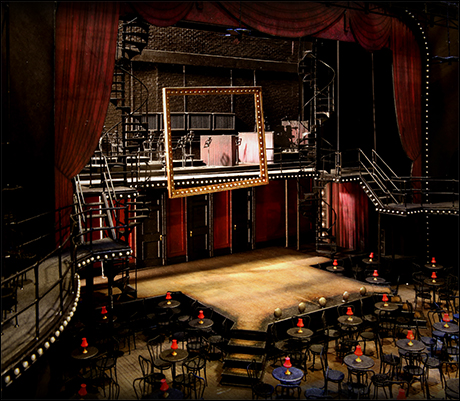*
“I’ve remounted opera productions where we’ve presented them in the past and are mounting them with a new company,” mused Robert Brill, scenic designer of the Roundabout Theatre Company production of Cabaret, which is enjoying a return engagement at the company’s Studio 54.
“But this is the first time I’ve completely recreated a production that has had this kind of history to it, and had a successful run before.”
The original Broadway revival of this Cabaret, co-directed by Sam Mendes and Rob Marshall, had a long run on Broadway, from 1998 to 2004 — first at the Kit Kat Klub (aka, the Henry Miller’s Theatre, on W. 43rd Street) and then at the old Studio 54, a dance club that was repurposed for the production and is now owned by the Roundabout.
Remounting Cabaret isn’t the same as restaging any old production from the past — a matter of finding the set and throwing it back onstage. Mendes, Marshall and Brill’s environmental rendition came not just with its own set, but, in effect, its own theatre. A large part of the orchestra seating was made up to look like a Weimar Republic club, with classic cabaret seating consisting of free-standing chairs and small round tables that could support small lamps and cocktail glasses. Bringing back Cabaret meant nothing less than bringing back the Studio 54 of 1998. The enterprise took a few months to complete. Nonetheless, Brill said, "It’s been a real pleasure to recreate it from scratch."
That’s right: From scratch. Back in 2004, when Cabaret finally closed, the Roundabout didn’t envision a scenario where it would revive the exact same production. Little to none of the set design was saved, except for a few tables and props.
"None of it was warehoused somewhere," told Brill. "We didn’t dust it off and put it back into the theatre. There were four or five props that we managed to find, not because they were stored for a future version of Cabaret, but just because they happened to find them in their warehouse."
One of those surviving props was the bentwood chair that Sally Bowles used in the number "Don’t Tell Mama." It has lived in the Roundabout’s reception offices since the original show closed. "It was one of the first props to come to the rehearsal halls when we began rehearsals," said Brill.
To recreate the rest of the set, Brill turned to his original drawings and documents of the production. But it wasn’t as easy summoning up blueprints with a few keystrokes on his laptop.
"That was a whole different time and place, right?," he said of 1998 — only 16 years ago, but, in digital years, the equivalent of a few generations. "We’re so much more electronic now. We’re so used to having things at our fingertips." Some of the documents, which were kept in Brill’s storage space in New York, were water-damaged. "We spent a lot of time trying to decide what was designed for Studio 54 and what was designed for the Henry Miller's."
Given a second chance, Brill decided to improve upon what he had accomplished a decade and a half ago.
"We’ve tried to faithfully recreate the audience experience," he said, "and we’ve even enhanced it." Painterly textures and levels of simulated distress were improved over 1998 standards. Also, there were practical concerns. "ADA compliance is now very key," said Brill, speaking of the Americans with Disabilities Act. "How do we allow for wheelchairs in the space? In a cabaret space, you have to look at each area and plan for that."
For the little glowing table lamps and their red lampshades, Brill was lucky enough to be able to turn the same vendors who created the originals.
 |
| The converted Studio 54 |
When Brill entered the defunct Studio 54 back in 1998, there wasn’t even a stage to work with.
"The whole interior was green and gold," he recalled. "I think it had had been renovated a few years beforehand and was used for photo shoot. The original idea of Studio 54 was that everyone was in the spotlight. The stage was brought to the level of the orchestra, so everyone was onstage. No matter where you were, you were on the dance floor."
A stage was built from the floor up, as was terracing for audience seating. The balcony, an event space made of steel and concrete, had to be completely demolished. "There was a lot of work that went into a very short period of time in 1998," recalled Brill, "a little over a two-month period."
The cabaret seating of Studio 54 held firm through the run of Cabaret and even remained for the subsequent revival of Stephen Sondheim’s Assassins. Soon after, conventional rows of cushioned seating were installed.
To bring back Cabaret, that process has been reversed, taking out not just the seats, but some of the seat terracing as well. "We had to remove the seating and recreate the whole infrastructure for the orchestra," said Brill, "which includes railings and wiring for the table lamps. It seems very simple, but it’s quite a task.
"It’s an amazing experience that I rarely get to do," commented Brill. "My background was originally in architecture. Doing something that’s a combination of theatre and architecture, like this one, it’s an approach that..." He paused, mid-statement, and reconsidered. "Well, I can’t even say a once in a lifetime experience," he added, laughing, "because this is the third that we’ve had a chance to do it — twice in the first year and now this year!"










